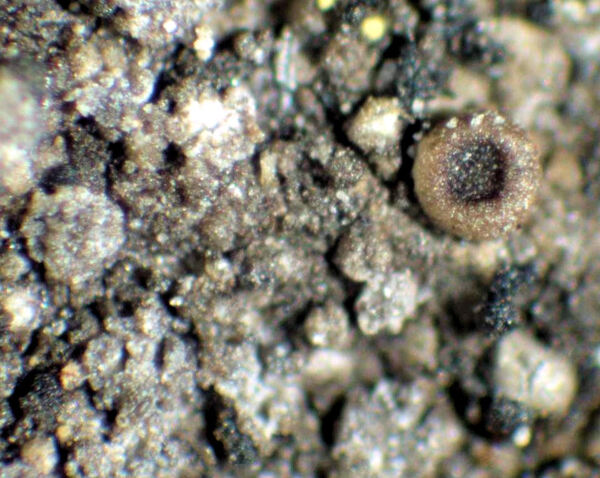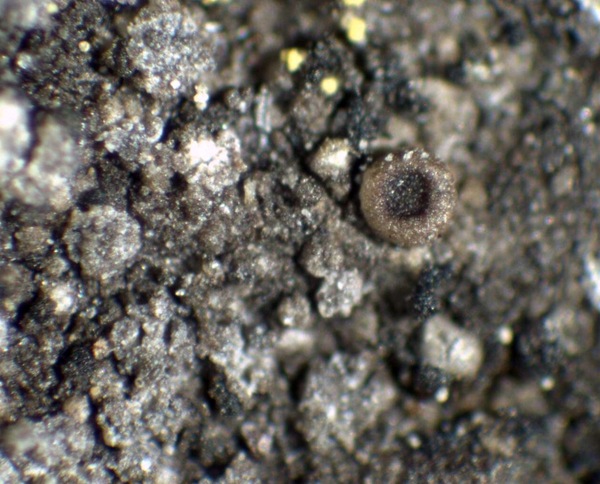Rinodina griseosoralifera Coppins
Lichenologist, 21: 169, 1989.
Synonyms:
Distribution: N - Frl, Lig (TSB 33566). C - Sar (ASU-516331, det. J. Sheard).
Description: Thallus crustose, episubstratic, forming up to 10 cm wide parches, areolate, sorediate, often delimited by a brown prothallus, the areoles dull greenish white, pale grey or greyish brown, 0.1-0.6 mm wide, rounded, flat to slightly convex, usually becoming entirely dissolved into soredia. Soralia numerous, blue-grey, erupting from the upper surface of the areoles, more or less convex, up to 0.2 mm in diam., discrete or a few confluent. Soredia farinose, 12-25(-30) μm in diam., the outer ones blue-grey, K+ brown Apothecia rare, lecanorine, 0.3-0.4 mm across, sessile, with a more or less poriform, brown disc, and a raised, white-grey thalline margin; proper margin brown, forming a narrow ring around the disc. Thalline exciple 70-80 µm wide laterally, expanding in lower part, the cortex ca. 10 µm thick, densely inspersed with crystals, the medulla without crystals; proper exciple brownish in uppermost part, otherwise colourless, c. 15 µm wide laterally, expanding to ca. 30 µm in upper part; epithecium brown, K-; hymenium colourless, up to 125 μm high, the hymenial gel K/I+ blue; paraphyses simple to sparingly branched in upper part, 1.5-2(-3) μm thick at mid-level, the apical cells 3.5-4.5 μm wide; hpothecium colourless, up to 40 μm high. Asci 8-spored, clavate, the K/I+ blue tholus penetrated by a faintly amyloid apical cushion with parallel or diverging flanks, the wall K/I-, surrounded by a K/I+ blue outer layer, Lecanora-type. Ascospores 1-septate, brown, ellipsoid, 18-25(-34) x 10-12(-15) μm, Pachysporaria-type, with a narrow torus, the walls not ornamented. Photobiont chlorococcoid. Spot tests: thallus K+ (sometimes faintly) yellow, C-, KC-, P- or P+ faintly yellow, UV-. Chemistry: atranorin, zeorin, traces of an unidentified terpenoid.Note: a species found on trunks of broad-leaved trees, often near the base, sometimes invading epiphytic mosses; easy to overlook, being mostly sterile, it is probably more widespread throughout the country, mostly at relatively low elevations. It was included in the Italian red list of epiphytic lichens as “Data Deficient” (Nascimbene & al. 2013c).
Growth form: Crustose
Substrata: bark
Photobiont: green algae other than Trentepohlia
Reproductive strategy: mainly asexual, by soredia, or soredia-like structures (e.g. blastidia)
Commonnes-rarity: (info)
Alpine belt: absent
Subalpine belt: absent
Oromediterranean belt: absent
Montane belt: extremely rare
Submediterranean belt: very rare
Padanian area: absent
Humid submediterranean belt: very rare
Humid mediterranean belt: absent
Dry mediterranean belt: absent
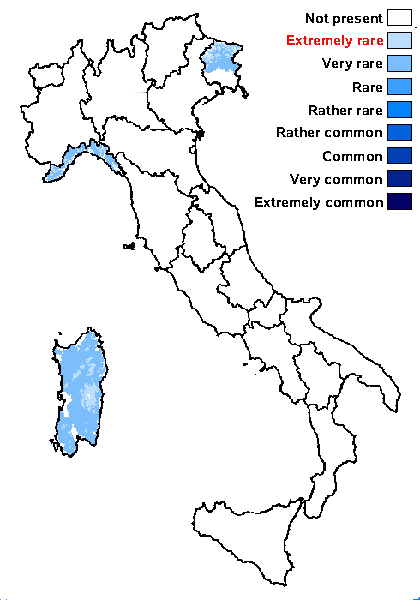
Predictive model
Herbarium samples
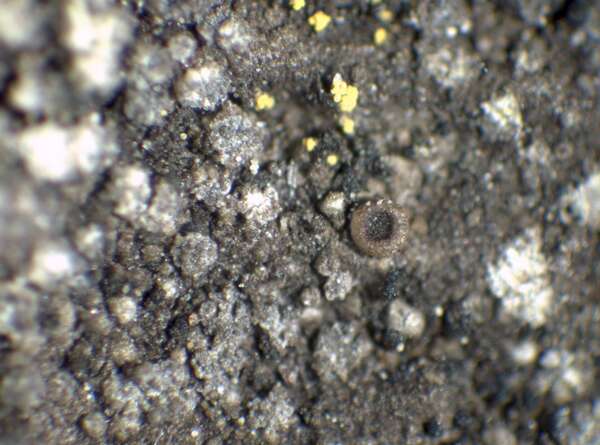

P.L. Nimis; Owner: Department of Life Sciences, University of Trieste
Herbarium: TSB (25277)
2002/05/13
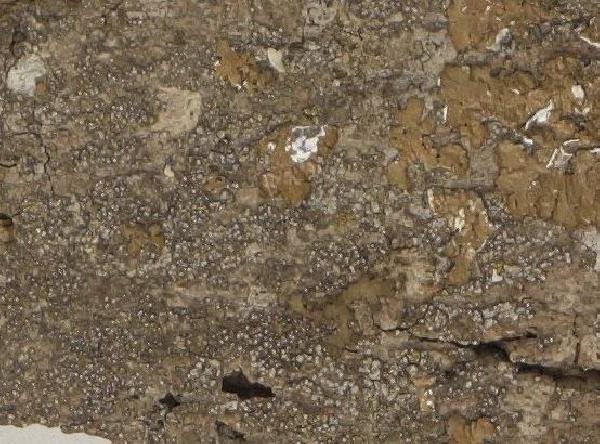
Modified from: https://gzu.jacq.org/GZU000299617
GZU000299617 - Collector Coppins,B.J. 4672
Date 1980-03-13
Location United Kingdom
Label Dunbarton, Loch Lomond: Ross Priory ; Alt. 15 m
Habitat on trunk of Acer pseudoplatanus in avenue
Habitus
Annotations 26/41.87
[A. Scharfetter (GZU) 2013-03-05: Label shows additionally handwritten annotation (by B. Coppins?) "Isotypus", also J. Poelt annoted "Isotypus" directly on card with mounted specimen, but according to protolog it is a paratype.]
Growth form: Crustose
Substrata: bark
Photobiont: green algae other than Trentepohlia
Reproductive strategy: mainly asexual, by soredia, or soredia-like structures (e.g. blastidia)
Commonnes-rarity: (info)
Alpine belt: absent
Subalpine belt: absent
Oromediterranean belt: absent
Montane belt: extremely rare
Submediterranean belt: very rare
Padanian area: absent
Humid submediterranean belt: very rare
Humid mediterranean belt: absent
Dry mediterranean belt: absent

Predictive model
| Herbarium samples |


P.L. Nimis; Owner: Department of Life Sciences, University of Trieste
Herbarium: TSB (25277)
2002/05/13

 INDEX FUNGORUM
INDEX FUNGORUM
 GBIF
GBIF
 DOLICHENS
DOLICHENS
